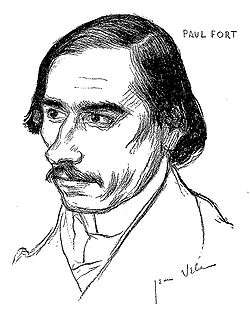Paul Fort
| Paul Fort | |
|---|---|
|
Drawing of Fort by artist Jean Veber. | |
| Born |
1 February 1872 Reims, France |
| Died |
20 April 1960 (aged 88) Montlhéry, France |
| Occupation | Lecturer, poet, playwright |
| Nationality | French |
| Alma mater | Lycée Louis-le-Grand |
| Literary movement | Symbolism, Futurism |
| Notable awards |
Prix Lasserre (1936) Grand Prix de Littérature (1956) Chevalier, French Légion d'Honneur |
Paul Fort (1 February 1872—20 April 1960) was a French poet associated with the Symbolist movement. At the age of 18, reacting against the Naturalistic theatre, Fort founded the Théâtre d'Art (1890–93). He also founded and edited the literary reviews Livre d'Art with Alfred Jarry and Vers et Prose (1905–14) with poet Guillaume Apollinaire, which published the work of Paul Valéry and other important Symbolist writers. Fort is notable for his enormous volume of poetry, having published more than thirty volumes of ballads and, according to Amy Lowell for creating the polyphonic prose form in his 'Ballades francaises' .[1]
Life and career
Born in Reims, Marne département, France, he became an important part of the artistic community of Montparnasse. While a student at the Lycée Louis-le-Grand in Paris, he founded the Théâtre d' Art in 1890. Many new artists were promoted there, including Paul Verlaine, Paul Gauguin, and Maurice Maeterlinck.[2] By 1912 his accomplishments and influence were such that Verlaine gave him the title "Prince of the Poets."
One of his famous works was "La Ronde". This poem is famous world wide because it is a plea for world friendship.
He died on 20 April 1960 in France and is buried in the Cimetière de Montlhéry, in Montlhéry, Essonne département, in the Île-de-France, Region of France.
| French literature |
|---|
| by category |
| French literary history |
| French writers |
|
| Portals |
|
Theater Experience
He frequented the café Voltaire, the headquarters of the Symbolist Poets breaking with the naturalistic scene including prevails Théâtre Libre created in 1887 by André Antoine in 1887, what motivated his expulsion from high school.
Willing to offer a scene to Maurice Maeterlinck, who he admired in drama, he created in 1889, with Lugné-Poe, the Art Theater that became the Théâtre Libre. The theater reveals the Nordic drama of Henrik Ibsen and August Strindberg.
Poet
Poetic creation after war
The theatrical adventure he had achieved, he dedicated his life to poetry. He gave his first poems to the Mercure de France in 1896. Those poems consisted the debut of the Ballades françaises (17 volumes written entering 1922 and 1958). He begins to publish into the Le Livre d'art magazine in 1892 where it was relaunched in 1896 with Maurice Dumont. With the latter, he edited the L'Épreuve, Journal-Album d'art in 1894.
He organized as soon as 1903, where he held poetic lectures every Tuesday at the Closerie des Lilas. In 1905, he started the Vers et prose magazine with Moréas and Salmon, who notably edited the works Guillaume Apollinaire, Max Jacob, Pierre Louÿs. He directed it with Paul Valéry. Pierre Louÿs who wrote the prelude to the first volume, that defines the Ballades like the small poems that are towards polymorphic or in Alexandrien familiarities, but it alters the prose and demand (this is the negligible point) not the diction of the verse, but the rhythmic prose.
Given the title "commandeur de la Légion d'honneur", he helped to give the quartier du Montparnasse in Paris his artistic reputation. He was called the "Prince of Poets" in 1912 following a poll consist of 5 journals: Gil Blas, Comoedia, La Phalange, Les Loups and Les Nouvelles. 350 authors voted for Paul Fort, who succeeded Verlaine, Mallarmé and Léon Dierx.
In August 1913, he led his sixteen years old daughter, Jeanne, to the altar where she marries Gino Severini- a futuristic painter. This event appealed to Guillaume Apollinaire and Marinetti, the authors of Manifeste du Futurisme. Nonetheless, however, Apollinaire, in a letter from 30 September 1915 to Madeleine Pagès, writes: “I have received the lyric report where Paul Fort, prince of poets sings the battle from afar and the truly stupid language.”
The Third Republic of the Poet Laureate
Paul Fort was a leading member of the Prix Jeunesse that was created in 1934. The l'Académie Goncourt candidates in 1943 faced André Billy, who died in June 1942, at the headquarters of Pierre Champion, Fort would not be elected even after Billy's death due to complicated matters, was only announced after the Libération.
He was the first one to be listed banning of publication by the CNE (National Writers' Committee, organized by intellectual resistance) at the end of war,he was then taken off of the second publication list in Les Lettres françaises on 21 October 1944.
It officially came back to Reims, in 1954, introduced to an exhibit that was dedicated to him at the Carnegie Library.
In 1956, Paul married Germaine Pouget. His nephew married to the daughter of Alfred Vallette (1858–1935), director of Mercure de France and Marguerite Eymery (1860–1953), women of letters known as Rachilde.
Trivia
Fort is mentioned by Hemingway as a customer of Closerie des Lilas, in A Moveable Feast.[3]
References
- ↑ Lowell,Amy A Consideration of Modern Poetry ,North american Review , Jan 1917
- ↑ Maurice Maeterlinck, Bettina Knapp, (Twayne Publishers: Boston), 40.
- ↑ The Restored Edition, Scribners, 2009.
External links
| Wikiquote has quotations related to: Paul Fort |
| Wikimedia Commons has media related to Paul Fort. |
